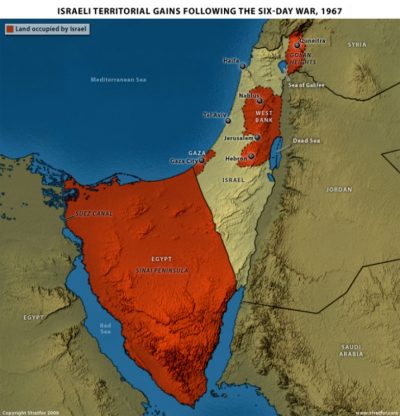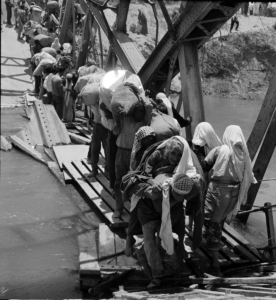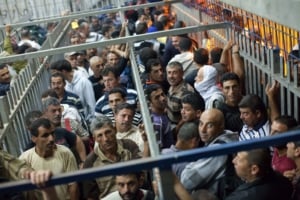Fifty Years Later: Myths and Facts About the Six Day War

This article is based on a talk by Richard Becker at a PSL forum in San Francisco on June 3, 2017
June 5 marks the 50th anniversary of Israel’s Six-Day War of conquest. Any objective examination of that war, and the events leading to and following it, make clear that the dominant narrative in the United States is reality turned upside down. It is “fake news” that is perpetrated on the public by the corporate media continually, right up to the present day.
The Six Day War began on June 5, 1967. Israel launched the war against Egypt, Syria and Jordan with what could correctly called a “sneak attack,” although it is never referred to that way here. In the vocabulary of imperialism, there was one “sneak attack” in history, that was, of course, when Japan attacked Pearl Harbor in 1941.
U.S. corporate media sometime refers to the Israel lightning assault on Egypt, Syria and Jordan as a “pre-emptive” strike, implying that Israel was about to be attacked, and only headed it off by attacking first, and was thus acting in self-defense.
Israel, as this one goes, was surrounded and about to be attacked by a “sea of Arabs” – another favored and demonizing expression common in the corporate media. So, as this false narrative goes, Israel had no choice but to launch massive air, land and sea assaults on neighboring countries, conquering the West Bank, East Jerusalem, Gaza, Egypt’s Sinai Peninsula and Syria’s Golan Heights. Israel has held on to all those areas except Sinai for the past half-century.
In the opening hours of its attack, Israel destroyed the Egyptian and Syrian air forces, basically determining the outcome.
A war of conquest – testified to by Israeli leaders after the fact
Most of the mainstream media, along with Israel’s apologists in the United States, propagated the notion that the war was a rerun of the biblical “David versus Goliath” battle. Israel was pictured as the heroic underdog, with God once more on its side.

Palestinian refugees flee across Jordan River, 1967
The misnamed, U.S.-based “Anti-Defamation League,” which has long served as propagandist for the Israeli regime, said that “Israel launched a preemptive strike against Egypt,” suggesting that it only did so to avert annihilation.
None other than the extreme right-wing Israeli Prime Minister Menachem Begin later exposed the utter falsity of such claims. Fifteen years after the war, in an Aug. 2, 1982, speech to the Israeli National Defense College, Begin said:
“We must be honest with ourselves. We decided to attack him [Egyptian President Gamal Abdul Nasser].”
It was not just Begin who exposed the myth. Ten years earlier, Gen. Mattiyahu Peled, one of the Israeli commanders in the 1967 Six-Day War, told the Israeli newspaper Ha’aretz:
“The thesis that the danger of genocide was hanging over us in June 1967 and that Israel was fighting for its physical existence is only a bluff, which was born and developed after the war.”
In 1997, Israel’s minister of defense at the time of the Six-Day War, Moshe Dayan, talked to the New York Times about the events leading up to the war on the Syria-Israel front. He stated that the Israeli kibbutz (cooperative farm) residents in the area wanted to take over the rich farmland of Syria’s Golan Heights:
“They didn’t even try to hide their greed for that land.”
Describing Israel’s tactics on its border with Syria, Dayan told the Times:
“We would send a tractor to plow some area where it wasn’t possible to do anything, in the demilitarized area, and knew in advance that the Syrians would start to shoot. If they didn’t shoot, we would tell the tractor to advance further, until in the end the Syrians would get annoyed and shoot. And then we would use artillery and later the air force also, and that’s how it was. … The Syrians, on the fourth day of the war [June 9, 1967], were not a threat to us.”
By the 1967 war, Israel succeeded in achieving its long-held objective of expansion. The remaining 22 percent of historic Palestine—the West Bank and Gaza—was conquered by Israel’s surprise attack, along with Syria’s Golan Heights and Egypt’s Sinai Peninsula.
More than 35,000 Arabs were killed, many of them burned to death by Pentagon-supplied napalm bombs. Thousands more were wounded. Most of the Egyptian, Syrian and Jordanian air and armor forces were destroyed in the opening days of the surprise attack. The Israeli army drove more than 90,000 Syrians and Palestinians out of the Golan Heights, an agriculturally rich region north of the Sea of Galilee.
Many of the Syrian villages and Golan’s main city, Quneitra, were bulldozed by the Israeli military. Israeli settlers began arriving in Golan in July 1967. In 1981, the Israeli Knesset (parliament) passed a law annexing the Golan Heights. The continuing occupation of Golan, as well as the West Bank and Gaza, defies scores of United Nations resolutions.
Israel’s long-sought “second round”
Israeli leaders had been seeking a “second round,” that is another war to expand their territory, since the formation of their state in 1948.
Moshe Dayan, a young military officer and protégé of David Ben-Gurion, Israel’s first prime minister, was quoted by a Tel Aviv-based U.S. diplomat in 1949 as saying:
“Boundaries-Frontier of Israel should be on Jordan [River]. … Present boundaries ridiculous from all points of view.” To achieve that aim meant taking over the West Bank.
In the first years after their expulsion, Palestinians frequently crossed the illegal and artificial border separating the territory under Israeli control from the West Bank, usually to return to their stolen lands and homes. Most often this happened during the planting and harvest season. Smaller numbers returned as groups of fighters, or fedayeen, seeking to continue the struggle. Israeli army orders were to kill any “infiltrators,” including those who were unarmed.
In response to fedayeen operations, the Israeli army would often carry out large-scale “retaliation.” The aim was not only to punish – “retaliation” actually meant provocation. The intent was to get Jordan, then administering the West Bank, to react militarily, which could then be used by Israel as a pretext for a new war of conquest.
In October 1953, a unit of the Israeli military under the command of war criminal and future prime minister Ariel Sharon carried out one such assault on the small border village of Qibya, wiping out the entire population of 69 people, mostly women, children and elderly men, many of whom were burned alive inside their homes. The Israeli forces suffered no casualties.
The Qibya massacre elicited world condemnation, but not the new war with Jordan that Israeli leaders were seeking as a pretext to seize the West Bank.
Israel’s next major attempt at territorial expansion came in 1956, when the Israeli, British and French governments met in secret to plan a new war on Egypt. The three each had their own objectives.
When the progressive government of Gamal Abdel Naaser announced the nationalization of the Suez Canal in July 1956, the British ruling class’s reaction was rabid fury. The canal was a central symbol of British imperial power. It was also the key economic route to the British colonies and neo-colonies in Asia and East Africa.
The French government believed that overthrowing the Egyptian government would strike a lethal blow to the Algerian Revolution.
Israel’s aim was to vastly expand its territory.
The 1956 War and Ben-Gurion’s ‘fantastic proposal’
From Oct. 22 to 24, 1956, a secret conference was held in Sevres, near Paris, to put the final touches on the war plans. Ben-Gurion surprised the other leaders present by presenting what he called a “fantastic proposal” for the complete reorganization of the Middle East. Jordan, he suggested, was not a viable state and should become part of Iraq—which was still under British domination—with one condition: The new Iraq would have to agree to resettle all the Palestinian refugees from 1948 on the East Bank of the Jordan River. The West Bank, minus the Palestinians living there, would become part of Israel. (Avi Shlaim, The Iron Wall, New York, 2001, p. 172)
Next, Ben-Gurion proposed, Israel would take over southern Lebanon up to the Litani River. The rest of Lebanon would become a “Christian state” with the restoration of French domination. Lebanon had been a French colony until 1943.
The Nasser government would be overthrown, the Suez Canal would be “internationalized,” and British influence would be restored in Egypt. This would mean, in effect, British control of the canal. Israel would take over the Sinai Peninsula, the Straits of Tiran, and the Gulf of Aqaba leading to the Red Sea.
The downfall of Nasser, according to the Israeli plan, would undermine both the Pan-Arab movement and the Algerian Revolution, to the benefit of all three conspiring states.

Palestinians at Israeli checkpoint in West Bank, 2016
Israel’s territory would be tripled in size by this plan. And while Ben-Gurion himself called the plan “fantastic,” he was dead serious about it.
Ben-Gurion’s proposal was too overreaching for the imperialist leaders of Britain and France. The plan they agreed on, however, was only slightly less ambitious.
On October 29, 1956, the tri-partite alliance attacked without warning. Israeli forces quickly swept across the Sinai, and British troops re-occupied the Suez Canal Zone. Ben-Gurion euphorically proclaimed that Sinai and Gaza would become “part of the third kingdom of Israel.”
But it was not to be. The 1956 Suez War was seen widely as a blatant attempt to resurrect colonialism—especially in the Middle East, but also across the world. Israel was widely condemned as a pawn of imperialism.
Both the United States and Soviet Union responded swiftly and strongly to the Tripartite Invasion—but for very different reasons. The Eisenhower administration reacted furiously for not having been informed in advance by either its imperialist allies or Israel.
More fundamental than any emotion was the U.S. ruling class’s opposition to the restoration of British and French imperial power in the strategically key and oil-rich Middle East. From World War II to the present day, every administration—including Eisenhower’s—has held U.S. domination of the region as a central objective.
Nor would Washington tolerate Israel serving as proxy for other imperialist powers. The message was sent to the Israeli government that if it did not withdraw from Egypt, all aid from official sources as well as private fundraising efforts in the United States would be cut off. Further, the United States would allow Israel to be expelled from the United Nations.
Soviet premier Nikolai Bulganin warned the British, French and Israeli governments that his country would unleash rocket attacks on their cities if they did not immediately withdraw. These warnings had to be taken very seriously, particularly because Eisenhower had ordered the withdrawal of the U.S. protective nuclear shield over the three countries.
Facing such irresistible pressures, the invading powers were forced out. As they withdrew, the Israelis waged a scorched-earth campaign, destroying every road, railroad and structure of any value in Egypt’s Sinai.
For the Israelis, while their “third kingdom” would have to be put on hold, significant gains were made from the episode. Israel acquired both vital military aid and the beginning of a nuclear weapons program.
The 1956 Suez War led within a very short time to Israel being brought fully into the U.S. camp. By its next war against the Arab world in 1967, Israel was closely aligned with and supplied by the U.S. military, and gained territory it had long been seeking.
Aftermath of 1967 – Rise of the Palestinian Resistance
With the conquest of the remaining 22 percent of Palestine in 1967, it appeared that the fate of the Palestinian people had been sealed. But in a seeming paradox, the Six Day War led to the rise of the Palestinian resistance movement and new wave of popular radicalization across the region.
Until the 1967 war, organizations such as Fatah- Palestine National Liberation Movement, and the Arab National Movement led by George Habash, had placed their main hope for the liberation of Palestine with the Arab armies. The outcome of the war brought that period to a close. In 1968, Fatah and two organizations which emerged from the ANM, the Popular Front for the Liberation of Palestine and the Democratic Front for Liberation of Palestine, took control of the Palestine Liberation Organization and launched mass resistance against the occupiers.
Since then, the struggle has continued in many forms and the vicious Israeli repression funded by the U.S., has taken an enormous toll. The dispossession of the Palestinian, the killings, systematic torture, the illegal settlements, the house demolitions, the destruction of olive and fruit groves, the theft of water, the lethal blockade and isolation of Gaza, the apartheid practice of the right of return, the apartheid roads, the apartheid everything – continue day after day.
Since the 1967 war, according the Addameer prisoner rights organization, 800,000 Palestinian men, more than 40% of the adult male population, have been imprisoned. Today, there are more than 6,300 Palestinians in Israeli prisons – every one of them held in violation of international law. And there are 0 Israelis held in Palestinian prisons. If that were the one and only fact one knew about the conflict there, one would know who is the colonizer and who is the colonized, who is the oppressor and who are the oppressed.
The Palestinian liberation struggle continues under the most difficult conditions. Many times since 1948, the Palestinians have been counted out, but they have never surrendered.
(Historical material in this article is taken from Palestine, Israel and the U.S. Empire. PSL Publications, 2009)
All images in this article are from the author.

